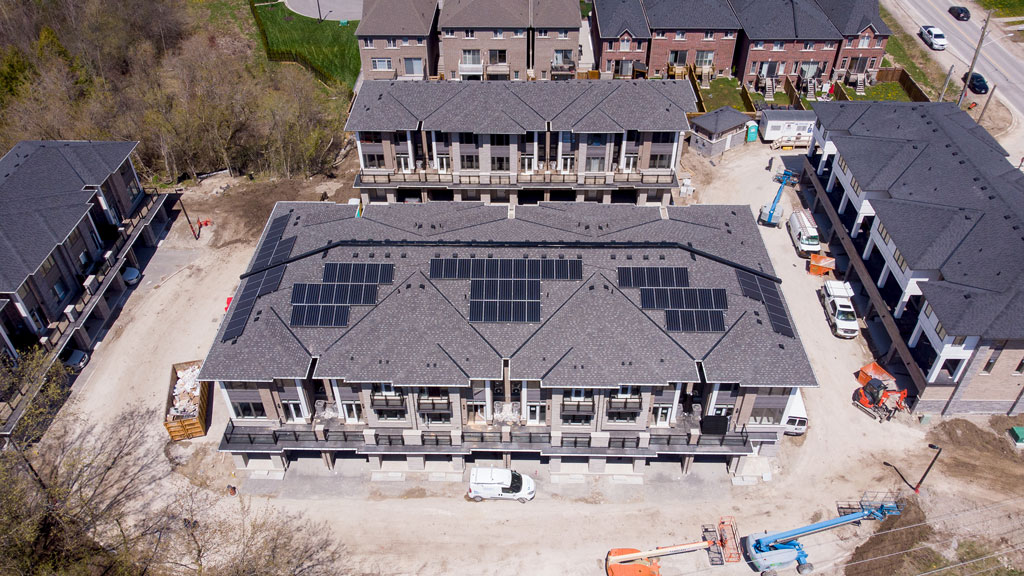A new smart microgrid community in Pickering, Ont. demonstrates how developers, communities and hydro companies can work together to create more energy-efficient housing developments while helping homeowners reduce their electricity bills.
“What is unique about it is that it is both an energy generation storage island but it’s also an active participant in the community grid,” explained Dugald Wells, general manager at Marshall Homes.
“From the very beginning planning stages it was designed to generate and store its own electricity. It can generate its own clean energy, store its own energy for its own use, be self-reliant in the case of a power outage and contribute to the power grid.”
Altona Towns, comprised of 27 units, is one of the first communities of its kind in Canada. It is expected to provide homeowners with a 10 to 12 per cent reduction to their electricity bill. The microgrid’s design includes a 25-kilowatt solar array of panels installed on the roof of one of the housing blocks and provides an estimated 10 per cent of the total power needed to run the community.
In addition to the fully integrated microgrid, the community also includes seven EV charging stations and a Tesla standalone battery that stores excess electricity. The microgrid is integrated into the regional power grid but with its smart metering system, the community can draw from it when needed, indicates a release.
Every homeowner also has technology inside their homes to help monitor electricity use.
Located on a 1.5 acre site in west Pickering, the Independent System Electricity Operator (IESO), Opus One Solutions, Elexicon Energy and Marshall Homes partnered to create the development which includes four blocks with a combination of rear-lane towns, back-to-back towns and conventional towns. The project is funded in part by the IESO’s Grid Innovation Fund.
The team includes Hunt Design Associates (architectural designers); Candevcon East Limited (civil consulting engineers); Brian Moss & Associates Ltd. (planner); Cosburn Nauboris Ltd. (landscape architect); and Alan Clarke (electrical consulting engineer).
Wells said he was intrigued when he found out Opus One got funding for a demonstration project.
“We had this development on the drawing board and we thought the conservation authority would be interested because this is very green,” said Wells. “We proposed the idea of locating the infrastructure behind the development within the conservation authority’s limits of interest. They agreed. We ended up offering to work with them on it. From there, we dealt with some hurdles, some of that was technical but a lot of it was organizational in terms of how would you actually do something like this and make it work.”
Although the site was acquired over seven years ago, it contained a lot of fill brought in from the previous owner that needed to be cleaned up which was expensive and took a lot of time.
Servicing on the site began in summer 2019 and construction was set to begin just as the COVID-19 pandemic hit. Construction officially began in July 2020 and the site was occupied in April.
It is a standard condominium development, which the developer would not normally have done for 27 towns.
“The problem was when you’ve got this microgrid infrastructure, the battery and the solar panels, it becomes of question of who owns it, who maintains it, how does this work?” he explained. “What we decided was the best thing to do would be to make it a standard condo so the condo corp. would own the equipment and would be the party to the agreement with the utility. One of the biggest challenges was figuring out how to do that.
“A cheque goes to the condo corp. annually and the condo corp. distributes the proceeds that come from that equally to all the residents through a reduction in condo fees,” he added, stating it might be roughly 10 per cent of the residents’ power bill.
When it comes to developing other microgrid communities, one of the hurdles is the technology is zooming ahead but the bureaucratic infrastructure is behind.
“It was OK to do this as a demonstration project but in terms of its ongoing operation, the policies were not in place and are still not in place, so this remains a demonstration project with a fixed time horizon,” Wells noted. “The partners entered this agreement for a 10-year period after which there will have to be a decision made about these assets. We hope by then that there will be policies in place.”



Recent Comments